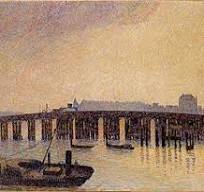Ben Webster plays Chelsea Bridge
You say web, I still think Webster, as in Ben, the Kansas City-born tenor saxophone legend and star of Duke Ellington’s early forties orchestra. But what Peter Chilton means is the website he manages for New England Public Radio. Pete created and launched a new look to the site today, and in honor of his efforts, I’m dedicating my first post on the new site to him.
Here’s Ben Webster playing “Chelsea Bridge,” Billy Strayhorn’s renowned work of jazz impressionism. This performance was filmed in 1964 after Webster, who was 55, had taken up residence in Copenhagen. London-born Stan Tracey, who died in December, is here at the piano. Webster was the soloist on the premier recording of “Chelsea Bridge” in 1941, and the tune was identified with him for the rest of his career.
Though Billy Strayhorn hadn’t yet been to London, his harmonically advanced composition was inspired by one of the renderings of the famous 19th century bridge (aka Battersea and Victoria) spanning the Thames. But which view was it? Camille Pissarro’s 1871 painting, Old Chelsea Bridge, a classic of French Impressionism that’s now in the collection of the Smith College Museum of Art?

Or was it Whistler’s 1872 painting, Nocturne: Blue and Gold – Old Battersea Bridge? My eye prefers the Pissarro, which has more of the pastel quality that Gunther Schuller heard in Strayhorn’s arrangement. Schuller devotes a few pages to “Chelsea Bridge” in his monumental study, The Swing Era, where he writes, “bright colors and high voicings predominate, but by being stated in softer dynamics their effect is more pastel than vivid.” Then again, the bluer hue of the Whistler may have been Strayhorn’s inspiration, especially in his decision to feature Webster as the tune’s principal soloist. The blues tinged just about everything Webster played, right down to his audible breaths.

“Chelsea Bridge” was first recorded by the Ellington Orchestra in 1941 with Strayhorn at the piano. A few years earlier, the bridge depicted in Pissarro’s and Whistler’s paintings had been replaced by a new span, but Strayhorn, whose teenaged undertaking, “Lush Life,” displayed a cosmopolitanism uncommon in even the most seasoned traveler, was the kind of old soul who would have been taken with the historic original.
There’s another “Chelsea Bridge” in this clip from the CBS television special, Jazz From Studio 61. At 5:29, you’ll see Ben, Hank Jones, George Duvivier, and Jo Jones in a performance that Jazz Standards author Ted Gioia singled out in his essay on “Chelsea Bridge” as “ethereal.” I hope you like it, Pete. Thanks for providing NEPR listeners with a new and improved platform on which to reach these great sounds and images.